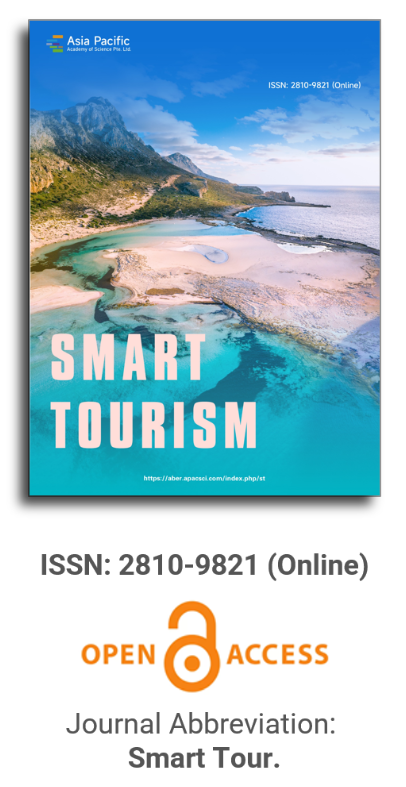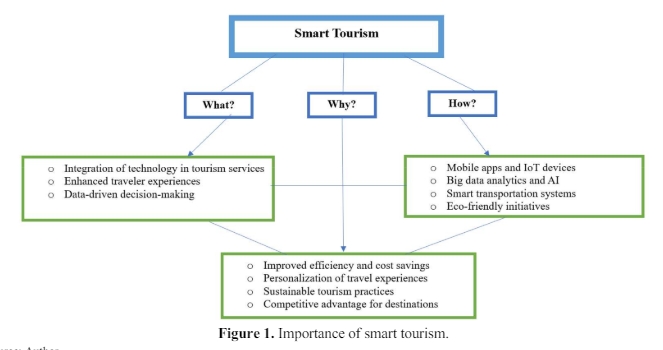
Publication Frequency
Semi-annual
Journal Articles
Search
Search scope
Volume Arrangement
Featured Articles

This commentary critically examines the integration of smart tourism technologies within the tourism and hospitality sectors, focusing on their role in enhancing tourist experiences and operational efficiencies. Through a multidisciplinary approach encompassing a literature review, case studies, and empirical data analysis, the analysis adopts a constructivist perspective to explore tourists’ subjective experiences with technology. It highlights significant personalization, efficiency, and sustainability advancements while acknowledging challenges related to digital infrastructure and privacy concerns. Advocating for a balanced and sustainable approach that respects environmental integrity and cultural heritage, the commentary concludes with recommendations for future research on the socio-economic impacts of smart tourism, ethical data usage, and the adaptation of technologies to diverse contexts. It calls for increased investment in digital infrastructure and stakeholder collaborative efforts to promote sustainable and inclusive tourism development.

The importance of the image of the tourist destination in the communication and marketing of a tourist destination is beyond doubt. For this reason, numerous studies address these issues. However, not so many do so from the perspective of the emotion the receiver feels, which is why this study deals with analyzing the emotion generated in the receiver through neuromarketing techniques and measuring the level of engagement felt. As a fundamental part of this study, we added the variable of cultural differences, both generically and specifically for gender and age. We are mainly guided by the theories of Life Cycle Theory and Generational Theory to analyze age differences. At the same time, gender differences are approached from the Gender Role Theory. The sample comprises one hundred individuals with apparent cultural differences, one sample of German origin and residence and the other of Spanish origin and residence, 50/50. We approached the study from the point of view of the emotion felt by the receiver of the message based on ten neuromarketing techniques (EGG) and ten images used by a famous tourist destination known in both countries. The results suggest that not only are there differences in the emotion felt after viewing images of a tourist destination, but that these differences are also explained by cultural background, gender, and age.
| Issue | Title | |
| Vol 2, No 2 (2021) | Research progress and enlightenment on the application of social media in tourism abroad | Abstract PDF |
| Min Peng, Xiaozhong Yang, Wenfeng Qu, Feifei Fan | ||
| Vol 1, No 2 (2020) | Review of research on smart tourism at home and abroad | Abstract PDF |
| Jucheng Zhang, Yiming Li, Ruxia Cheng | ||
| Section Collection | Significant guidance for the effective management of construction waste in North Africa and the Middle East countries | Abstract PDF |
| Nivin Ghaboun | ||
| Vol 3, No 1 (2022) | From the perspective of the visitor, smart beach management: Rosarito, Baja California, Mexico | Abstract PDF |
| Isaac Cruz-Estrada, Ana M Miranda-Zavala, Margarita Ramírez-Torres | ||
| Vol 2, No 1 (2021) | Smart tourism destination initiatives in the city of Natal-RN: A qualitative approach | Abstract PDF |
| Holliver Breno Barbosa de Freitas, Luiz Mendes Filho | ||
| Vol 1, No 2 (2020) | Smart tourism destination, physical experience and rural tourism | Abstract PDF |
| Francisco J. Ballina Ballina | ||
| Vol 3, No 2 (2022) | Smart tourism destinations: The backbone of tourism recovery | Abstract PDF |
| Andrés Fernández Alcantud, Beatriz García Moreno | ||
| Vol 3, No 1 (2022) | Smart Tourism Destinations—Reminder to the host community | Abstract PDF |
| Julio César González Morales | ||
| Vol 2, No 1 (2021) | Smart tourist destinations, a new conceptual contribution for local development in Ecuador. Case “Portoviejo UNESCO Creative City” | Abstract PDF |
| Ángel Guillermo Félix Mendoza, Johnny Patricio Bayas Escudero, José Rafael Vera Vera, Washington Fernando Veloz Camejo, Joffre Ramón Moreira Pico | ||
| Vol 3, No 2 (2022) | Spatial structure characteristics and effects of self-driving tourism flows before and after the new crown epidemic: Taking Yunnan Province as an example | Abstract PDF |
| Xiaofeng Ji, Miao Yu, Fang Chen, Jing Li, Yicheng Ge | ||
| Vol 3, No 1 (2022) | Study on the construction of smart tourism ecosystem and polycentric governance mechanism | Abstract PDF |
| Yong Yu, Hui Wang | ||
| Vol 1, No 2 (2020) | Study on the development path of cultural tourism resources in Balikun reclamation | Abstract PDF |
| Chunxiang Zhang | ||
| Vol 2, No 2 (2021) | Survey on some key technologies of virtual tourism system based on Web3D | Abstract PDF |
| Yulan Tan, Jinyuan Jia, Shuo Peng, Anmin Huang, Guangyao Li | ||
| Vol 3, No 1 (2022) | The notion and connotation of smart tourism through the lens of rational choice | Abstract PDF |
| Jingyi Li, Yunpeng Li, Zequn Ning, Wenli Chen | ||
| Section Collection | The Eighth Wonder of the World in New Zealand: Seismic studies confirm the new Hochstetter paradigm | Abstract PDF |
| Alfred Rex Bunn | ||
| Vol 4, No 1 (2023) | The importance of the government’s role in sustainable development in rural areas | Abstract PDF |
| Andi Cudai Nur, Tilemachos Koliopoulos, Risma Niswaty, Haedar Akib | ||
| Vol 2, No 1 (2021) | The physical and the virtual in urban tourist practices—The case of Buenos Aires, Argentina | Abstract PDF |
| Mercedes González Bracco, Linda Kotschack | ||
| Vol 3, No 2 (2022) | The relationship between age and stress during the pandemic in Ecuador—Tourism strategy recommendations | Abstract PDF |
| Manuel Antonio Abarca Zaquinaula, Matius Rodolfo Mendoza Poma, Freddy Anaximandro Alvarez Lema, Milton Alberto Sampedro Arrieta | ||
| Vol 3, No 1 (2022) | The value of intelligent services and intelligent destination: From the perspective of residents | Abstract PDF |
| Ángel Herrero Crespo, Héctor San Martín Gutiérrez, María del Mar García de los Salmones Sánchez | ||
| Vol 3, No 2 (2022) | Tourism: Difficulties, costs and integration in the 21st century | Abstract PDF |
| Stella Arnaiz Burne, Aledo A César Dáchary, Fernanda César Arnaiz | ||
| Vol 4, No 1 (2023) | Trends in cultural tourism | Abstract PDF |
| Pilar Espeso-Molinero | ||
| Vol 3, No 1 (2022) | Triple helix stakeholder visions for smart tourism | Abstract PDF |
| Sandra Patricia Rojas-Berrio, Jeisson Leonardo Rincón-Novoa, Luz Alexandra Montoya-Restrepo | ||
| Vol 2, No 1 (2021) | Understanding the governance of smart destinations: The case of Florianopolis in Brazil | Abstract PDF |
| Adalberto Santos-Júnior, Alexandre Augusto-Biz, Fernando Almeida-García, Luiz Mendes-Filho | ||
| Vol 2, No 1 (2021) | Virtual accessibility in smart tourism destinations: The cases of Curitiba and Malaga | Abstract PDF |
| Diogo Lüders Fernandes, Enrique Torres Bernier | ||
| 101 - 124 of 124 Items | << < 1 2 3 4 5 | |
Editor-in-Chief

Prof. Hung-Che Wu
Nanfang College, Guangzhou
China
Indexing & Archiving
News & Announcements
2025-01-09
A Thank You Letter from Smart Tourism!
As we bid farewell to 2024, we take immense pride in reflecting on the 28 distinguished works that have been meticulously published online following a rigorous peer-review process. We extend our heartfelt gratitude for authors' invaluable contributions, reviewers' steadfast support, and EBM's insightful guidance throughout the year. Your dedication and expertise have been instrumental in propelling Smart Tourism towards its current success.
2024-07-05
Call for Reading: Volume 5 Issue 1 Available
We are pleased to announce the release of Volume 5 Issue 1 of Smart Tourism. We sincerely invite researchers to download and read articles in this issue. It is hopeful that the content will bring readers new perspectives and inspire the research in related field.
2024-01-15
New layout style in 2024
In 2024, Smart Tourism will adopt a new layout style. Please turn to the "Author Guidelines" for preparing your manuscripts.
Journal Center
Asia Pacific Academy of Science Pte. Ltd. (APACSCI) specializes in international journal publishing. APACSCI adopts the open access publishing model and provides an important communication bridge for academic groups whose interest fields include engineering, technology, medicine, computer, mathematics, agriculture and forestry, and environment.



.jpg)
.jpg)

.jpg)

